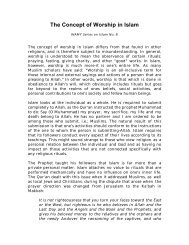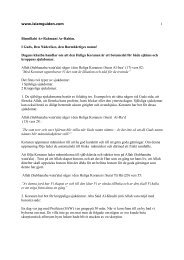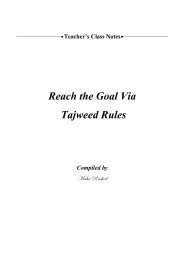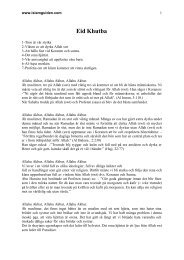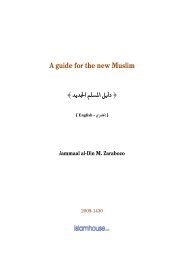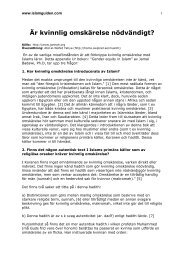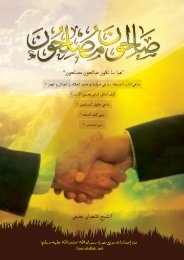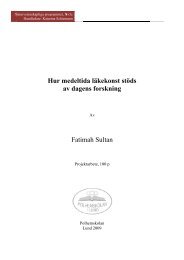The Prophet's Prayer From The beginning To The End As Though ...
The Prophet's Prayer From The beginning To The End As Though ...
The Prophet's Prayer From The beginning To The End As Though ...
You also want an ePaper? Increase the reach of your titles
YUMPU automatically turns print PDFs into web optimized ePapers that Google loves.
head from rukoo' and said: Allaah listens to the one who praises Him. When the Messenger of Allaah had finished his<br />
prayer, he said, Who was the one speaking just now <strong>The</strong> man said, "It was I, O Messenger of Allaah." So the Messenger of<br />
Allaah (sallallaahu 'alaihi wa sallam) said, I saw over thirty angels hurrying to be the first one to write it down. 74<br />
Lengthening this Standing, & the Obligation to be at Ease in it<br />
He (sallallaahu 'alaihi wa sallam) used to make this standing about as long as his rukoo', as has been mentioned; in fact, "he would<br />
stand (for so long) sometimes that one would say, 'He has forgotten', [because of his standing for so long.]" 75<br />
He used to instruct them to be at ease in it; hence, he said to "the one who prayed badly", ... Next, raise your head until you are<br />
standing straight [and every bone has taken its proper place] - in another narration, When you rise, make your spine upright and<br />
raise your head, until the bones return to their joints. 76<br />
He also reminded him: that no-one's prayer is complete unless he does that, and used to say: Allaah, Mighty and Sublime, does not<br />
look at the prayer of the slave who does not make his backbone upright in between his bowings and prostrations. 77<br />
<strong>The</strong> Sujood (Prostration)<br />
Next, "he (sallallaahu 'alaihi wa sallam) would say takbeer and go down into sajdah" 78 , and he ordered "the one who prayed badly"<br />
to do so, saying to him, No one's prayer is complete unless ... he says: Allaah listens to the one who praises Him and stands up<br />
straight, then says: Allaah is the Greatest and prostrates such that his joints are at rest. 79<br />
Also, "when he wanted to perform sajdah, he would say takbeer, [separate his hands from his sides,] and then perform sajdah." 80<br />
Sometimes, "he would raise his hands when performing sajdah." 81<br />
Going Down into the Sajdah on the Hands<br />
"He used to place his hands on the ground before his knees." 82<br />
He used to instruct likewise, saying, When one of you performs sajdah, he should not kneel like a camel, but should place his hands<br />
before his knees. 83<br />
He also used to say, Verily, the hands prostrate as the face prostrates, so when one of you places his face (on the ground), he<br />
should place his hands, and when he raises it, he should raise them. 84<br />
<strong>The</strong> Sajdah Described<br />
"He would support himself on his palms [and spread them]" 85 , "put his fingers together" 86 , and "point them towards the qiblah." 87<br />
Also, "he would put them (his palms) level with his shoulders" 88 , and sometimes "level with his ears" 89 . "He would put his nose and<br />
forehead firmly on the ground." 90<br />
He said to "the one who prayed badly", When you prostrate, then be firm in your prostration 91 ; in one narration: When you<br />
prostrate, put your face and hands down firmly, until all of your bones are relaxed in their proper places. 92<br />
He also used to say, "<strong>The</strong>re is no prayer for the one whose nose does not feel as much of the ground as the forehead." 93<br />
"He used to put his knees and toes down firmly" 94 , "point with the front of the toes towards the qiblah" 95 , "put his heels together" 96 ,<br />
"keep his feet upright" 97 , and "ordered likewise." 98<br />
Hence, these are the seven limbs on which he (sallallaahu 'alaihi wa sallam) would prostrate: the palms, the knees, the feet, and<br />
the forehead and nose - counting the last two as one limb in prostration, as he (sallallaahu 'alaihi wa sallam) said: I have been<br />
ordered to prostrate (in one narration: we have been ordered to prostrate) on seven bones: on the forehead ..., and he indicated by<br />
moving his hand 99 around his nose, the hands (in one version: the palms), the knees and the toes, and not to tuck up 100 the<br />
garments and hair. 101<br />
He also used to say, When a slave prostrates, seven limbs prostrate with him: his face, his palms, his knees and his feet. 102<br />
He said about a man who was praying with his hair tied 103 behind him, His example is surely like that of someone who prays with his<br />
hands bound (behind his back). 104 He also said, That is the saddle of the devil, i.e. where the devil sits, referring to the knots in the<br />
hair. 105<br />
٤٥




